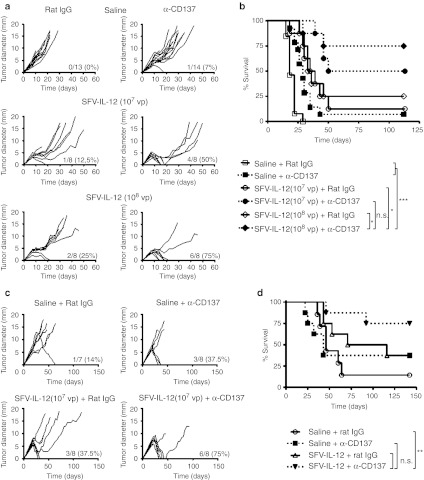Figure 1.
Treatment efficacy of SFV-IL-12 + anti-CD137 combination. (a) C57BL/6 female mice were inoculated in the flank with 5 × 105 B16-OVA cells on day 0 and then received an intratumoral injection of saline (top panels), 107 viral particles (vp) (middle panels), or 108 vp of SFV-IL-12 (bottom panels) on day 7. On days 7, 10, and 14 mice received intraperitoneally 100 µg of rat immunoglobulin G (IgG) (left panels) or anti-CD137 mAb (right panels). (c) C57BL/6 female mice were inoculated in the flank with 5 × 105 TC-1 cells on day 0 and then received an intratumoral injection of saline (top panels) or 107 vp of SFV-IL-12 (bottom panels) on day 18. On days 18, 22, and 26 mice received intraperitoneally 100 µg of rat immunoglobulin G (IgG) (left panels) or anti-CD137 mAb (right panels). (a,c) Each curve represents the evolution of the mean tumor diameter for each individual mouse. The numbers in the right lower corner of each graph indicate the fraction of tumor-free mice on day 60 (for the B16-OVA model) or on day 121 (for the TC-1 model) relative to the total number of animals in each group, and the percentage of complete tumor regressions, respectively. (b,d) Kaplan–Meier plots of mouse survival. The SFV-IL-12 + anti-CD137-treated group (108 vp in b) was compared with the rest of the groups with the log-rank test. n.s., not significant; *P < 0.05; ** P < 0.01;*** P < 0.001. (a,b) The graphs correspond to pooled data of two independent experiments with similar results. α, anti-. SFV-IL-12, Semliki Forest virus encoding interleukin-12.

